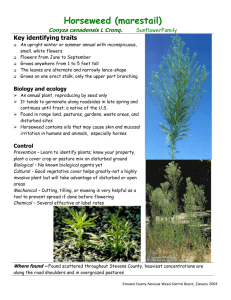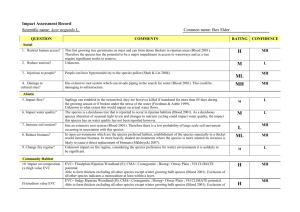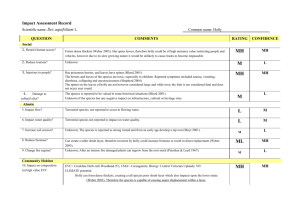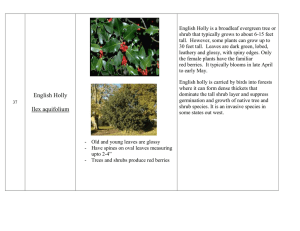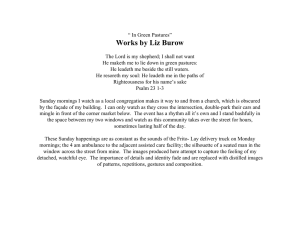H MH H ML L ML L L H H
advertisement
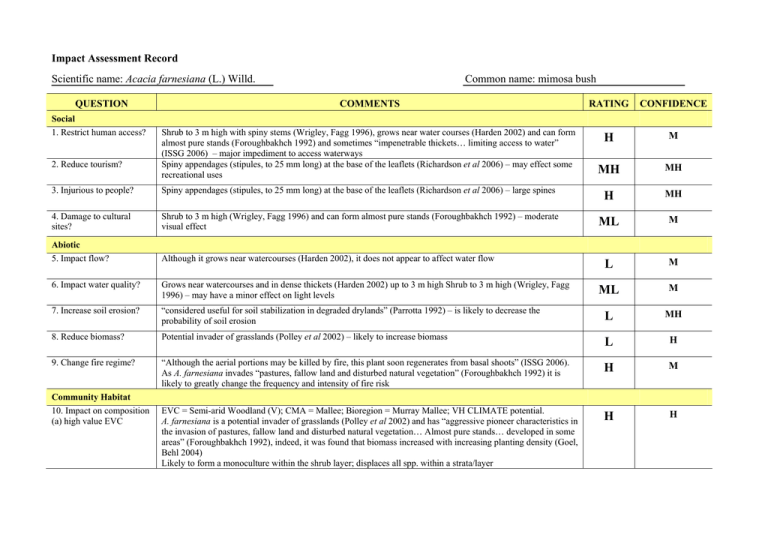
Impact Assessment Record Scientific name: Acacia farnesiana (L.) Willd. QUESTION Social 1. Restrict human access? 2. Reduce tourism? Common name: mimosa bush COMMENTS RATING CONFIDENCE Shrub to 3 m high with spiny stems (Wrigley, Fagg 1996), grows near water courses (Harden 2002) and can form almost pure stands (Foroughbakhch 1992) and sometimes “impenetrable thickets… limiting access to water” (ISSG 2006) – major impediment to access waterways Spiny appendages (stipules, to 25 mm long) at the base of the leaflets (Richardson et al 2006) – may effect some recreational uses H M MH MH 3. Injurious to people? Spiny appendages (stipules, to 25 mm long) at the base of the leaflets (Richardson et al 2006) – large spines H MH 4. Damage to cultural sites? Shrub to 3 m high (Wrigley, Fagg 1996) and can form almost pure stands (Foroughbakhch 1992) – moderate visual effect ML M Abiotic 5. Impact flow? Although it grows near watercourses (Harden 2002), it does not appear to affect water flow L M ML M 6. Impact water quality? Grows near watercourses and in dense thickets (Harden 2002) up to 3 m high Shrub to 3 m high (Wrigley, Fagg 1996) – may have a minor effect on light levels 7. Increase soil erosion? “considered useful for soil stabilization in degraded drylands” (Parrotta 1992) – is likely to decrease the probability of soil erosion L MH 8. Reduce biomass? Potential invader of grasslands (Polley et al 2002) – likely to increase biomass L H 9. Change fire regime? “Although the aerial portions may be killed by fire, this plant soon regenerates from basal shoots” (ISSG 2006). As A. farnesiana invades “pastures, fallow land and disturbed natural vegetation” (Foroughbakhch 1992) it is likely to greatly change the frequency and intensity of fire risk H M EVC = Semi-arid Woodland (V); CMA = Mallee; Bioregion = Murray Mallee; VH CLIMATE potential. A. farnesiana is a potential invader of grasslands (Polley et al 2002) and has “aggressive pioneer characteristics in the invasion of pastures, fallow land and disturbed natural vegetation… Almost pure stands… developed in some areas” (Foroughbakhch 1992), indeed, it was found that biomass increased with increasing planting density (Goel, Behl 2004) Likely to form a monoculture within the shrub layer; displaces all spp. within a strata/layer H H Community Habitat 10. Impact on composition (a) high value EVC Impact Assessment Record Scientific name: Acacia farnesiana (L.) Willd. QUESTION (b) medium value EVC (c) low value EVC 11. Impact on structure? 12. Effect on threatened flora? Fauna 13. Effect on threatened fauna? 14. Effect on nonthreatened fauna? 15. Benefits fauna? 16. Injurious to fauna? Pest Animal 17. Food source to pests? Common name: mimosa bush COMMENTS RATING CONFIDENCE EVC = Grassy Riverine Forest (D); CMA = North Central; Bioregion = Murray Fans; VH CLIMATE potential. A. farnesiana is a potential invader of grasslands (Polley et al 2002) and has “aggressive pioneer characteristics in the invasion of pastures, fallow land and disturbed natural vegetation… Almost pure stands… developed in some areas” (Foroughbakhch 1992), indeed, it was found that biomass increased with increasing planting density (Goel, Behl 2004) Likely to form a monoculture within the shrub layer; displaces all spp. within a strata/layer EVC = Sandstone Ridge Shrubland (LC); CMA = Mallee; Bioregion = Lowan Mallee; VH CLIMATE potential. A. farnesiana is a potential invader of grasslands (Polley et al 2002) and has “aggressive pioneer characteristics in the invasion of pastures, fallow land and disturbed natural vegetation… Almost pure stands… developed in some areas” (Foroughbakhch 1992), indeed, it was found that biomass increased with increasing planting density (Goel, Behl 2004) Likely to form a monoculture within the shrub layer; displaces all spp. within a strata/layer A. farnesiana is a potential invader of grasslands (Polley et al 2002) and has “aggressive pioneer characteristics in the invasion of pastures, fallow land and disturbed natural vegetation… Almost pure stands… developed in some areas” (Foroughbakhch 1992), indeed, it was found that biomass increased with increasing planting density (Goel, Behl 2004) – major effects on all layers. Forms monoculture. It has “aggressive pioneer characteristics in the invasion of pastures, fallow land and disturbed natural vegetation… [forms] almost pure stands” (Foroughbakhch 1992) – likely to effect threatened flora but this was not identified in the literature. H H H H H H MH L It has “aggressive pioneer characteristics in the invasion of pastures, fallow land and disturbed natural vegetation… [forms] almost pure stands” (Foroughbakhch 1992) – likely to effect habitat of threatened fauna was not identified in the literature. As it forms “impenetrable thickets” (ISSG 2006) it is likely to change habitat dramatically which may lead to the possible extinction of non-threatened fauna As it is a prickly shrub (Wrigley, Fagg 1996) it is likely to provide harbour for small birds, as well as provide nectar for nectar-feeders – provides an important alternative food source and harbour to desirable species The spiny appendages (stipules, to 25 mm long) at the base of the leaflets (Richardson et al 2006) – large spines likely to be dangerous to fauna MH L H M ML M H MH “The seed pods are nutritious and are readily eaten by ungulates” (ISSG 2006), e.g. wild horses, goats and pigs – supplies food for one or more minor pests spp. ML M Impact Assessment Record Scientific name: Acacia farnesiana (L.) Willd. QUESTION 18. Provides harbor? Agriculture 19. Impact yield? 20. Impact quality? 21. Affect land value? 22. Change land use? 23. Increase harvest costs? 24. Disease host/vector? Common name: mimosa bush RATING CONFIDENCE As it forms “impenetrable thickets” (ISSG 2006) it is likely to provide harbour and permanent warrens for foxes and rabbits throughout the year COMMENTS H M It is persistent “in heavily grazed, mechanically cut, and herbicide-treated pastures” (Parrotta 1992) and although in Australia “pastoralists have long tolerated it as drought forage” (Kull, Rangan 2008) it is digested poorly in sheep (Ramirez, Ledezma-Torres 1997) – may affect pasture quantity and therefore livestock access to feed – major impact on quantity of produce (5-20%) A known seed contaminant of hay from the top end in the Northern Territory (CLMA 2004) - this may lead to produce being rejected for sale or export “As it often forms thorny thickets along some watercourses in Australia…can also hinder access to water” (ISSG 2006) – may decrease land value > 10% “As it often forms thorny thickets along some watercourses in Australia, it can be a considerable nuisance during mustering and can also hinder access to water” (ISSG 2006). “Due to its prolific seed production, palatability to livestock, and rapid germination on disturbed soils, aroma can rapidly colonize pastures, often forming dense stands” (Parrotta 1992) – the fact that it is so hard to control and affects access to water may result in downgrading of the priority land use “As it often forms thorny thickets along some watercourses in Australia, it can be a considerable nuisance during mustering and can also hinder access to water” (ISSG 2006) – more time and labour would be required to regain access to waterways and to muster livestock None mentioned in the literature MH MH H M H M MH M H M M L
